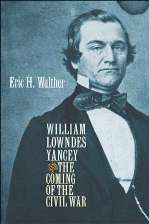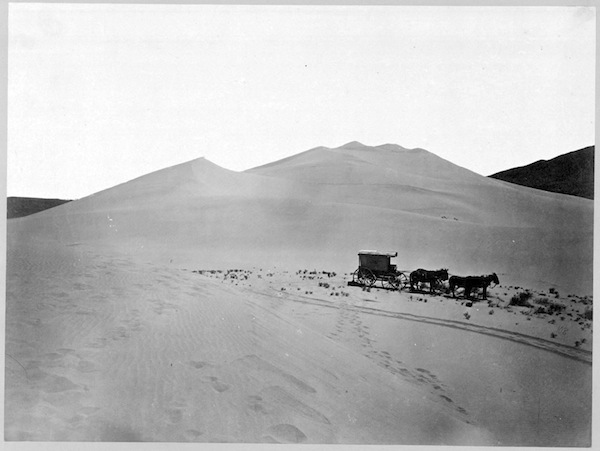A short biography of M. Jeff Thompson, which includes an explanation of the “M. Jeff”.
Tag Archives: biographies
Civil War Podcast #5 – The Fiery Gospel
I’m in over the wire this week, but hey – it’s still February 5th somewhere, so I’m counting it anyway!
This week, I celebrate the anniversary of The Battle Hymn of the Republic, published this day (or yesterday, if you want to get technical) in 1862.
You can download the podcast by visiting the February page and clicking on the MP3 link.
William Lowndes Yancey and the Coming of the Civil War
On Wednesday, the CWRT of Toronto had the pleasure of hearing Professor Eric H. Walther talk about the life of William L. Yancey, a very engaging talk on a very complicated man. I haven’t yet had the opportunity to Professor Walther’s biography of Yancey, but based on that talk it’ll be a terrific read.
Photo by Brady, Podcast of Brady
Today is the anniversary of Mathew Brady’s death. To learn more about the controversial “photojournalist”, click here and download the latest episode of the Civil War Podcast.
Podcast #2 – G.K. Warren
It’s G K Warren’s birthday. I hope you got him something nice. As for myself, I brought him a shiny new podcast. You can download it here.
Cullums Register
The Internet is a wonderful place. I’ve wondered, on several occasions, which general finished in what ranking at West Point. Turns out, General George Washington Cullum kept a list, and a hundred and some years later, Bill Thayer put it on the web. With short biographies accompanying the name of each graduate, this is a terrific resource for anyone interested in West Point history.
Cullums Register is an index to all the graduates of the Military Academy at West Point, in sequential order, class by class, and within each class, in the final order of merit they achieved as cadets — or at least from 1818 to 1978, when the Register dropped the order of merit. Each entry consists of a complete summary of the graduates official military career, and any synopsis of his civilian achievements that the editors managed to assemble. The overall numerical order of the entry of a graduate has come to be called his “Cullum number”, and commonly serves as an identifier.
The Register was first conceived by Gen. George Washington Cullum Class of 1833, ranking 3d in his Class; Superintendent of the Academy in 1864‑1866; his own Cullum number is 709. He started with a sort of draft version in 1850, then published it in its final form in a third edition, in three volumes, in 1891.
via Cullums Register.
Lesser Knowns
Much of the local newspaper content that filters through my inbox involves small stories of long-dead and long-forgotten local residents. This Columbus Dispatch article touches upon some of the middling players from the era’s national stage, also long-forgotten, but with some nifty personal anecdotes.
Formerly a Whig, he joined the new Republican Party and was named a delegate to the 1860 Republican Convention in Chicago.
Vocal demonstrations of support were important tools for candidates seeking to demonstrate strength at political conventions back then.
Lincoln, an underdog at the convention, didn’t secure enough delegates for the nomination on the first two ballots. When the roll was called for the third, Delano rose and delivered a one-sentence statement that electrified the crowd: “I desire to second the nomination of a man who can split rails and maul Democrats — Abraham Lincoln.”
via Ohioans loom large in lore of Lincoln | The Columbus Dispatch.
Timothy O’Sullivan, Explorer
A little biography of Tim O’Sullivan, which includes a few instances of his post-war photography. Modern critics rail at his manufacturing of the Civil War shots, but you can’t complain about those American West ones. Absolutely stunning. I’ll need to hunt down some O’Sullivan photo books to add to my collection.
In 1867, the War behind him, he used his fame to become the official photographer for the U.S. Geological Service’s “Exploration of the Fortieth Parallel.” The purpose of the exploration was as much political and promotional as it was scientific. The U.S. was stretching across the continent and the government wanted people to settle the heartland. O’Sullivan’s task was to create photographs to sell the West, and induce Easterners and foreign immigrants to settle in the new American territories.
Setting out from Virginia City, Nevada — a town that would later be immortalized in movies and TV series, including “Bonanza” — O’Sullivan headed into the Southwest. With boxes of glass plates and a wagon full of chemicals, he made photographs as he traveled using the wet plate collodion process. This process requires the photographer to coat the glass with a syrupy concoction of light-sensitive chemicals and make the exposure while the plate is wet. This means that wherever he went, he brought his darkroom — an old, horse drawn military ambulance fitted out for photographic processing — with him. Despite its difficulties, the wet collodion method served O’Sullivan well because it produced the highly detailed, grainless images he was after.
via How the American West was won with the help of photographer Timothy O’Sullivan – Imaging Resource.
More Thad Time
Thanks to this series by Lancaster Online, I can now pick Thad Stevens out of a lineup. The Pennsylvania online journal has offered a string of terrific short articles about the native son Senator. If you enjoy them as much as I did, be sure not to miss those on the second page – the button to click through is very small and easy to miss.
Uncommon attention: Revisiting Thaddeus Stevens – LancasterOnline.com.
Woman With Flare
Disunion discusses a rare duck: Lady scientist of the 1860s, Martha Coston. Nice to see that the Coston name remained tied to the product, though I wonder how many flare users were aware that the Coston in question wore petticoats?
Coston made her mark in history because she needed to survive, after her husband´s untimely death. At age 16, Coston eloped with the promising Boston scientist Benjamin Franklin Coston, who headed the Navy´s pyrotechnic laboratory. She had four children with him over the next five years. Apparently due to his work with toxic materials, Benjamin Coston died a somewhat mysterious death in 1848, leaving his 21-year-old widow and children nearly penniless.
Luckily, Martha Coston had followed her husband’s work, and knew that he had developed a revolutionary new signaling system: a wand signal that displayed three colors on a rotating rod. On the advice of Secretary of the Navy Isaac Toucey, Coston persuaded the home fleet to test the signal prototypes her husband had crafted. After testing it, Commodore Hiram Paulding wrote Coston that the idea was an excellent one.
But because her husband died in mid-development, he hadn’t left much behind in the way of schematics or formulas. Coston basically had to start from scratch to determine how to make the signal lights. Over many months Coston labored tirelessly to perfect the flare signals.


